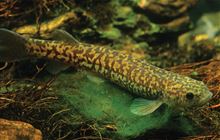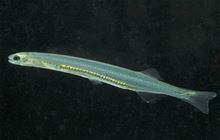Whitebait management frequently asked questions
Introduction
We've provided answers to some questions about our whitebait work to date and the consultation.Why is DOC reviewing whitebait management?
DOC is reviewing whitebait management to ensure whitebait populations are healthy.
This includes identifying how to restore them where they have declined, and what’s needed for a sustainable whitebait fishery.
What is the current status of whitebait management work?
In January and February 2020, we consulted on ways to improve whitebait management, which included a review of regulations for whitebait fishing. The regulations for whitebait fishing will not change for the 2020 season.
We're currently reviewing over 11,000 submissions that we received during the consultation to inform our recommendations to the Minister of Conservation.
Once we've finished our review, we'll provide the submissions to the Minister of Conservation with a summary and recommendations on amendments to regulations. The Minister of Conservation will then consider our recommendations, and discuss them with Parliamentary colleagues.
The decision on regulatory amendments will be made by Cabinet. After that, new regulations would be drafted to incorporate changes.
The regulations for whitebait fishing did not change for the 2020 season. Our work to manage whitebait and support compliance with current regulations is also continuing throughout this process.
What did the consultation in 2020 propose?
The consultation sought public feedback on:
- a management goal for the six species fished as whitebait
- management outcomes for the whitebait fishery
- amendments to the whitebait fishing regulations
- phase out export of the whitebait.
What were the proposed regulations in the 2020 consultation's discussion document?
Regulatory changes proposed in the discussion document include changing the whitebait fishing season, whitebait fishing practices, introducing whitebait refuges, and other options to improve whitebait management.
Any proposals for new regulations will be developed after the consultation process has closed, and we’ve considered the submissions. Cabinet will decide whether to establish new regulations and what they will be.
Read more about the proposed regulation changes
Aren’t the whitebait refuges proposed during the 2020 consultation places where whitebaiting is banned?
Setting aside places where whitebaiting is not allowed to help conserve whitebait numbers isn’t new. Permanent whitebaiting bans are already in place in some waterways on the West Coast.
The Minister of Conservation and Cabinet will decide whether to create new whitebait refuges and their locations after consultation.
Three timeframes are proposed for the possible exclusion of fishing in some waterways.
See maps of possible refuge locations
Did DOC engage New Zealanders when preparing the 2020 consultation proposals?
DOC’s engaged New Zealanders on options for whitebait management from mid-2018 through to early 2019. DOC received contributions from more than 3,000 people. We prepared and released a report in May 2019 which summarised their feedback.
The report included options to address pressures facing whitebait and potential management tools.
The Minister of Conservation considered this feedback and directed DOC to proceed to public consultation on whitebait management, which is now taking place.
Learn more about the 2018/19 engagement process
Who provided their views to the 2018 engagement process which led to the current consultation?
Approximately 400 people attended public drop-in sessions to share their views. 2,875 people shared their thoughts via an online survey.
We summarised all feedback in our report ‘New Zealanders' views on whitebait management: Summary of findings from a public engagement process’. Contributors included iwi, Māori, stakeholders and the public.
We provided feedback from iwi and Māori directly to the Minister of Conservation. It was also included in the report.
A Whitebait Working Group was established to contribute to this work. This group reflected the range of interests that New Zealanders have in whitebait. The working group also considered feedback from iwi, Māori and stakeholders.
Who were the members of the Whitebait Working Group?
We invited members to participate in the working group because of their expertise in different aspects of whitebait.
This included mātauranga Māori, commercial and recreational fishing, habitat restoration, fisheries and species management, and freshwater policy and ecology.
What stops DOC going ahead and choosing its preferred regulatory changes?
Government consultation on regulatory changes is subject to a clearly defined process and final decisions are made by Cabinet. DOC is not a decision-maker in this process.
DOC must consider all the submissions we receive from the public on the proposals and set out how we’ve responded. We must also explain our rationale for our recommendations to government.
The Minister of Conservation and Cabinet will then decide if new regulations will progress and what those are, based on DOC’s rationale and the submissions received.
Do we know enough about whitebait to manage them properly?
DOC published a report summarising the current knowledge about whitebait in 2018. This report showed that we have good knowledge in some areas such as the habitat and distribution of whitebait species, and general pressures and threats. It also noted gaps, like the exact effects of harvest on each of the six species. Harvest is acknowledged as one pressure on the species.
While gaps in our knowledge of whitebait create challenges, we can still improve the management of these and their fishery.
Expert knowledge and data show that habitat quality is declining and that the number of adult whitebait of some species are also declining. This means there will be fewer juveniles.
Read the report: Conservation, ecology and management of migratory galaxiids and the whitebait fishery.
Could this end commercial whitebaiting?
The consultation did not propose any changes to the domestic sale of whitebait.
If whitebait are threatened, why don’t you ban whitebaiting?
A ban on whitebaiting isn’t necessary to ensure healthy and restored whitebait populations.
What assurances can you give that you won't ban whitebaiting?
It’s not DOC’s or the Minister of Conservation’s intent to stop whitebait fishing. There are no proposals to ban whitebaiting. The purpose of the consultation is to improve whitebait management.
Isn't DOC creating uncertainty for whitebaiters who worry they won't be able to fish?
We understand that this kind of regulatory review can create uncertainty.
Our work with New Zealanders in 2018 found most people believe we need changes for a more sustainable whitebait fishery. This includes whitebaiters, who have contributed extensively to the process.
The discussion document sets out several options intended to help ensure that whitebait fishing can continue.
Does this consultation have anything to do with the Conservation (Indigenous Freshwater Fish) Amendment Bill?
In October 2019, the Conservation (Indigenous Freshwater Fish) Amendment Bill passed its third reading and received Royal assent.
This Bill improved the suite of tools available for managing indigenous freshwater fish, e.g. protection for spawning sites. It did not specifically address the whitebait fishing regulations.


